How to Choose Between Hardside and Softside Luggage, According to Our Tests
Dotdash Meredith and Yahoo Inc. may earn commission or revenue on some items through the links below.
We mapped out the pros and cons of hardside versus softside suitcases for all traveler needs.
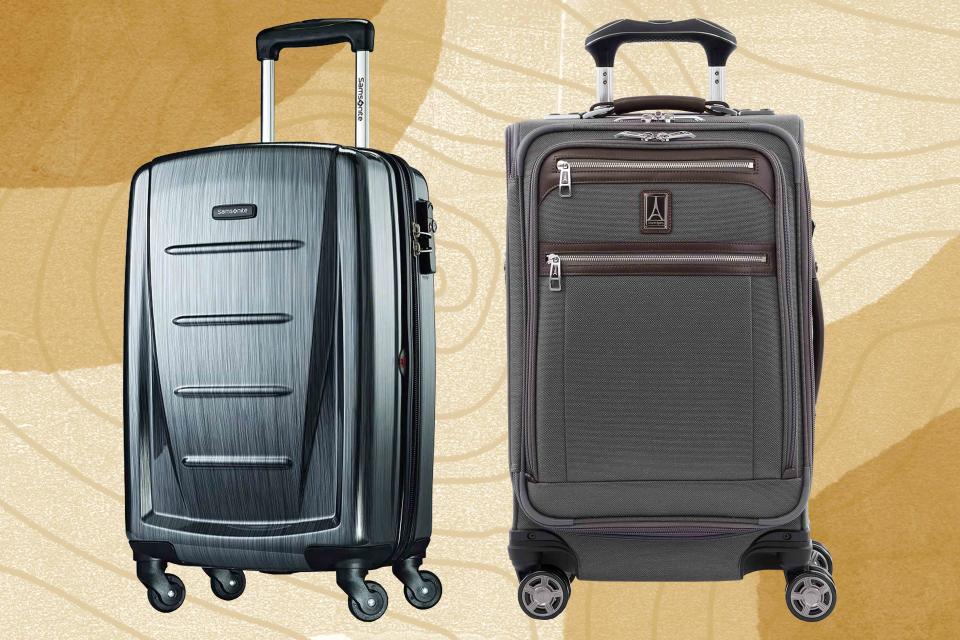
Travel + Leisure / Marcus Millan
It’s time to settle the long-time debate between the two types of suitcases on the market: hardside and softside luggage. While the final decision boils down to personal preference, we put together this comprehensive guide with cold hard facts to help you decide which style suits your needs.
In addition to the materials themselves, we evaluated the overall design, weight, and capacity considerations for both bag types. We also sifted through testing notes from more than 200 hardside and softside suitcases Travel + Leisure has personally tested so, once you pick team softside or team hardside, we narrowed it down to the best carry-on, checked, and underseat luggage pieces. Keep reading to learn more about the pros and cons of hardside and softside suitcases — and decide which will work best for you.
Hardside Luggage
Materials
Most hardshell suitcases are made out of polycarbonate, polypropylene, ABS (acrylonitrile butadiene styrene), or aluminum. Polycarbonate is one of the most durable and flexible materials so it's more impact-resistant but is also heavier than polypropylene and ABS bags. Polypropylene is the most lightweight when it comes to plastic hardshell bags while still remaining fairly durable.
ABS typically falls in the middle weight-wise — it is often the cheapest option but is commonly found in a blend with other materials. Aluminum, on the other hand, has the sleekest look but is usually the priciest and heaviest; it's the most protective which also means it has the least "give" out of the hardshell options when packing.
Arguably the biggest pros and cons of hardside luggage are related to the material used. A hardshell suitcase is typically better than a softside bag for protection (as long as your items are packed safely inside, too). However, all hardshell materials are prone to getting scuffed, scratched, or possibly cracked more so than with fabric suitcases. Just remember that it’s normal for hardshell suitcases to look beat up, particularly after checking them in but it’s usually not too difficult to buff the case with a sponge to remove the marks (and some suitcases even come with buffing sponges). You can also opt for colors that hide damage better like navy blue or black.
Design
One of the most appealing factors of hardside luggage is the sleek design. The shell is typically protective enough to safeguard your belongings during rough airport baggage handling, in-flight turbulence, or rainy delays on the tarmac, making the investment worth it for peace of mind. In general, you can expect to see four 360-degree spinner wheels on most hardshell suitcases which is ideal for maneuverability in crowded airports, too.
In terms of interior organization, there should be zippered sections or pocketed dividers to help pack a range of clothing items between the two clamshell-style compartments. However, you’d be hard-pressed to find exterior pockets on most hardside suitcases due to the stiff, solid plastic material so, once your items are packed away, it’ll be difficult to access anything. If this is important to you, seek out hardside suitcases with quick-entry front pockets to solve that problem.
Weight
While polypropylene is the lightest weight material in the hardside suitcase category, other hardshell suitcases will likely still be heavier than softside bags. Aluminum is very durable but it can be quite dense with most carry-ons weighing over 10 pounds. If weight is important to you for a checked bag with airline weight restrictions, you’ll be better off with a lighter-weight polypropylene suitcase or a softside one. In general, a hardside carry-on will weigh anywhere between 5 and 10 pounds and a lightweight checked bag will weigh 9 to 12 pounds.
Capacity
Since hardshell suitcases typically have a clamshell-style design, it's possible to naturally divide up a lot of items. You may find it easier to use packing cubes to help maximize space and stay organized since there are generally fewer pockets in hardside luggage. Conversely, hardside suitcases have less give in the material so it can be harder to squeeze extra items in.
Most hardside suitcases don’t have expandable zippers and, if they do, that likely won’t give as much extra wiggle room as with softside luggage. However, with hardside carry-ons, your suitcase will always fit in the overhead bin as long as it fits the airline’s dimension requirements as the structure of the bag won’t allow it to exceed its original size.
Our Top Picks
Best Checked: Samsonite Winfield 2 Hardside Luggage with Spinner Wheels
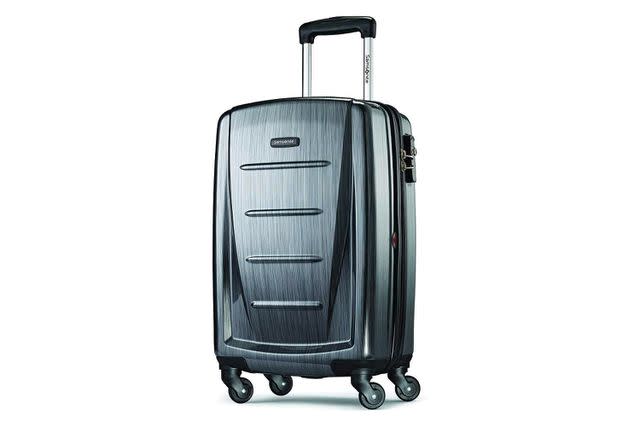
Why We Love It
The polycarbonate shell feels nearly indestructible.
What to Consider
It weighs 11.5 pounds which is on the heavier side for checked luggage.
Going on an international trip? This large Samsonite checked bag can fit more than a week’s worth of clothing items thanks to its generous capacity and built-in compression straps that help secure and compress clothes. Made out of durable polycarbonate, the suitcase helps protect all of your belongings no matter the conditions during transit. While it’s on the heavier end of the luggage spectrum at 11.5 pounds, it’s worth it for a durable and wallet-friendly checked suitcase.
Price at time of publish: $213
The Details: 11.5 pounds | 31.5 x 20.5 x 13 inches | Expandable | 4 spinner wheels
Best Carry-on: Samsonite Freeform Carry-on Spinner
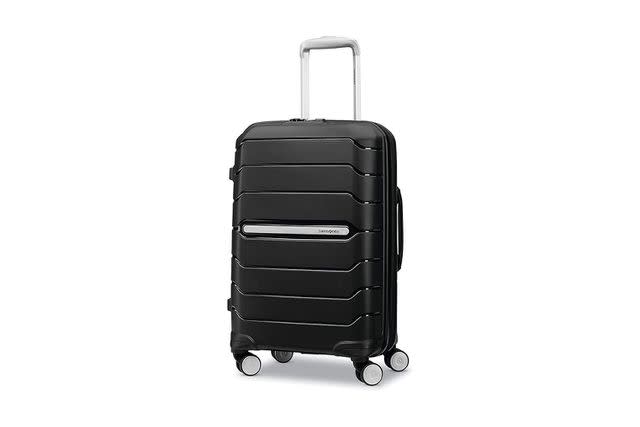
Why We Love It
It’s super lightweight but spacious enough for a variety of trips.
What to Consider
There could be more pockets for storage.
This polypropylene carry-on is exceptionally durable to withstand anything from accidental drops to transits in inclement weather. Its light weight will surely be appreciated when you’re lugging it from place to place, too. The clamshell-style suitcase has plenty of room for clothing, shoes, and anything else you need to travel with, but we do wish there were a few more interior pockets for smaller items. The four 360-degree wheels are very smooth and make it easy to maneuver around any airport or hotel obstacles.
Price at time of publish: $200
The Details: 5.6 pounds | 21 x 15 x 10 inches | Expandable | 4 spinner wheels
Best Underseat: Calpak Hue Mini Carry-On Luggage

Why We Love It
It has a variety of designated pockets to use the small space efficiently.
What to Consider
The TSA-approved lock has a slight learning curve.
Calpak’s underseat suitcase fits perfectly under a standard airplane seat and, although it’s hardsided, it has enough give to be squeezed underneath a smaller airplane seat, too. There are a variety of interior pockets for a laptop, phone charger, and other small items to stay organized while packing light, but you can still easily fit a weekend’s worth of clothes. Plus, the 360-degree wheels make it incredibly easy to roll this small polycarbonate suitcase through a busy airport.
Price at time of publish: $165
The Details: 16 x 13.5 x 8 inches | 6.05 pounds | 4 spinner wheels
Related: The Best Hardside Luggage of 2023, Tested and Reviewed
Softside Luggage
Materials
The most common fabrics used to make softside luggage are nylon and polyester. Higher-end softside luggage is often made with more durable materials like cordura and ballistic nylon whereas budget luggage may be made of a less durable polyester. Ballistic nylon was created during World War II and is a thicker woven fabric designed to be more resistant to abrasion, tearing, and odors. It can also result in a heavier bag.
Softside material can generally hide tears or stains better than a hardshell suitcase can hide scuffs or scratches but may still fray and fade over time. A big downside to softside luggage is that, although the fabric conceals damage better than hardshell luggage, your items may not be as well-protected in inclement weather transit so you may want to travel with a hardshell suitcase if you’re traveling to a cold or wet destination.
Design
There’s nothing more classic than a piece of softside luggage. While four 360-degree spinning wheels are the industry standard now for prime mobility, there are still quite a few softside suitcases with two wheels on the market. It’s ultimately a personal choice whether you find it easier to get around with four wheels rather than two but a suitcase with four wheels offers both options as it’s possible to drag this style as well as roll it by your side.
The typical design of a softside suitcase includes one large main compartment with a separate top flap that often has both interior and exterior pockets for organization. That option for external pockets is softside luggage’s most notable design feature as most hardshell suitcases lack these. In fact, most softside suitcases will have at least one large front zippered pocket with smaller pockets in or around the larger one.
Weight
Polyester fabric is very lightweight so, if you’re looking for a suitcase to stay within an airline’s strict limits, this softside luggage is a great option. (Remember that any wheels, handles, or the frame itself can add weightiness, too.) It ultimately depends on the brand and size of the suitcase itself but softside carry-ons can weigh as little as 4 pounds. Polyester checked bags typically weigh between 8 and 11 pounds, with ballistic nylon options often checking in around 15.
Capacity
When it comes to capacity, softside luggage truly shines. Nylon and polyester have more give than hardshell suitcases so there’s more room to cram items in if needed. Plus, softside luggage often comes with expandable zippers that can add several inches of room in the suitcase which is a game changer for squeezing in last-minute items. The front zipper pockets are also very helpful for easily accessing items while traveling and can keep you extra organized, too. However, remember when packing this style that you may inadvertently exceed overhead luggage size requirements with overstuffed or expanded bags.
Our Top Picks
Best Checked: Travelpro Platinum Elite 29-Inch Expandable Spinner

Why We Love It
The impressive capacity holds tons of items with plenty of pockets for storage.
What to Consider
The dimensions are larger than the typical 62-inch linear size restrictions.
If you’re looking to maximize your space when checking in a suitcase, the ballistic nylon Travelpro Platinum Expandable Spinner is your best choice. It has a variety of pockets for staying organized while packing it full of clothing and accessories, and it has an expandable zipper to add another 2 inches of room. Just be sure to note that the dimensions exceed the typical size restrictions of checked bags which is 62 linear inches so you may face extra fees at the baggage kiosk if you don’t check size restrictions ahead of time.
Price at time of publish: $470
The Details: 12 pounds | 32.5 x 21 x 13.5 inches | Expandable | 4 spinner wheels
Best Carry-on: Travelpro Platinum Elite 21” Expandable Carry-on Spinner
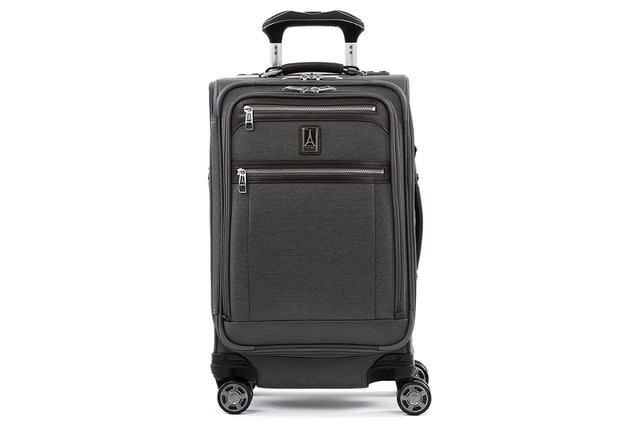
Why We Love It
The high-density nylon is super durable and the wheels roll smoothly across all types of surfaces.
What to Consider
It has a USB port but you have to buy a power bank separately.
When it comes to durability, Travelpro’s Platinum Elite Carry-on is made with a high-density ballistic nylon fabric with Duraguard coating to ensure the longevity of the suitcase. It has four spinner wheels that glide smoothly over rough and flat surfaces, and going around sharp corners is a breeze. The capacity is standard for a carry-on and there are a variety of internal and external pockets including a pocket with a USB port — but you’ll need to supply your own power bank to place in the compatible pocket.
Price at time of publish: $370
The Details: 8.3 pounds | 23.5 x 14.5 x 9 inches | Expandable | Smart | 4 spinner wheels
Best Underseat: Samsonite Spinner Underseater with USB Port
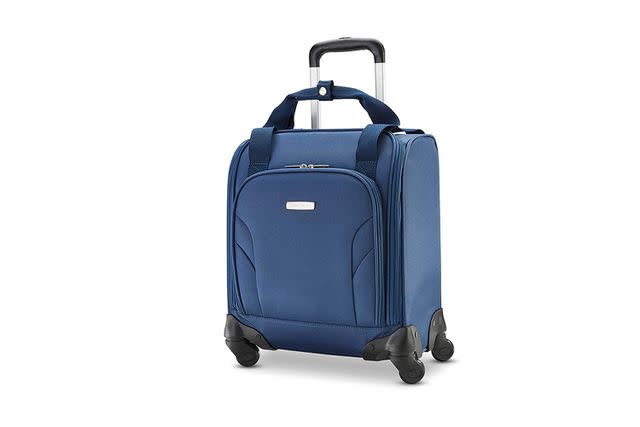
Why We Love It
The capacity is large enough for a weekend’s worth of clothing.
What to Consider
It might be a tight squeeze to fit under a seat.
The polyester Samsonite Spinner Underseater has an impressive capacity for fitting a variety of clothing items for a weekend getaway. Business travelers will appreciate the built-in USB port for charging electronics on the go and there is a 13.3-inch padded laptop sleeve pocket on the outside for convenient access while traveling. You may have to give the underseater a little shove to get it to fit underneath some airplane seats but the softside material has lots of give for compressing or expanding the suitcase.
Price at time of publish: $145
The Details: 16.5 x 13 x 9.5 inches | 6.17 pounds | Smart | 4 spinner wheels
Related: The Best Softside Suitcases of 2023, Tested and Reviewed
The Conclusion
There are pros and cons for both hardside and softside luggage so weigh all factors against your own needs before making a purchasing decision. Hardside luggage may be preferred by frequent fliers who prioritize super-durable luggage with organization flexibility, or for those in search of suitcases with a more sleek style. Softside luggage, on the other hand, caters to any traveler looking for a reliable piece of luggage packed with pockets that can be expanded and stuffed as needed.
Our Testing Process
We’ve tested more than 200 pieces of softside and hardside luggage in both our New York City lab and real-world settings. After these tests, we continue to use the suitcases for at least six months to get long-term testing notes so we can update our luggage articles frequently. No matter the size or style of the suitcase, we evaluated each bag based on the same traits including capacity, durability, design, and maneuverability to help us pick the very best luggage on the market for every traveler.
Frequently Asked Questions
What are the standard carry-on and checked luggage dimensions?
While it can certainly vary by airline, you’ll want to get a carry-on that measures about 22 x 14 x 9 inches and is easy to lift overhead without assistance when packed (if no specific weight requirements are posted). Checked luggage usually can’t exceed 62 linear inches and a weight of 50 pounds so the physical weight of that suitcase can play an important role in determining which one to get if you tend to overpack. Underseat luggage typically needs to measure 18 x 14 x 8 inches or smaller but can depend on the aircraft and carrier so always check the airline’s listed dimensions before any trip.
How should I pack a suitcase?
Packing a suitcase can be a tricky task, as it depends on the items you’re bringing. Generally, you want to distribute the weight evenly so the suitcase isn’t bottom- or top-heavy. If one end is heavier than the other, the suitcase could be difficult to lift or potentially land hard on one side while being handled by baggage attendants. If you need to save space or pack strategically, we recommend using regular or compression cubes to maximize your suitcase’s capacity.
Why Trust Travel + Leisure
Anna Popp is a commerce writer at T+L where she writes nearly all of the team’s tested articles whether products were evaluated in the lab or a real-world setting. Anna participates in every travel test and has tested luggage from nearly every popular luggage brand. She used her knowledge of jetsetting and luggage testing insights to put together this guide for buying hardside and softside luggage.
Related: The 8 Best Underseat Luggage Pieces of 2023, Tested and Reviewed
Love a great deal? Sign up for our T+L Recommends newsletter and we'll send you our favorite travel products each week.
For more Travel & Leisure news, make sure to sign up for our newsletter!
Read the original article on Travel & Leisure.

